Top Rankings
Beulah 27 School District ranks among the top 20% of public school district in North Dakota for:
Category
Attribute
Graduation Rate
Highest graduation rate (Top 5%)
Community Size
Largest student body (number of students) (Top 1%)
For the 2025 school year, there is 1 public middle school serving 240 students in Beulah 27 School District. This district's average middle testing ranking is 4/10, which is in the bottom 50% of public middle schools in North Dakota.
Public Middle School in Beulah 27 School District have an average math proficiency score of 37% (versus the North Dakota public middle school average of 36%), and reading proficiency score of 37% (versus the 44% statewide average).
Minority enrollment is 9% of the student body (majority Hispanic and American Indian), which is less than the North Dakota public middle school average of 29% (majority American Indian).
Overview
This School District
This State (ND)
# Schools
3 Schools
208 Schools
# Students
747 Students
39,176 Students
# Teachers
56 Teachers
3,481 Teachers
Student : Teacher Ratio
13:1
13:1
District Rank
Beulah 27 School District, which is ranked within the bottom 50% of all 167 school districts in North Dakota (based off of combined math and reading proficiency testing data) for the 2021-2022 school year.
The school district's graduation rate of 90% has stayed relatively flat over five school years.
Overall District Rank
#120 out of 169 school districts
(Bottom 50%)
(Bottom 50%)
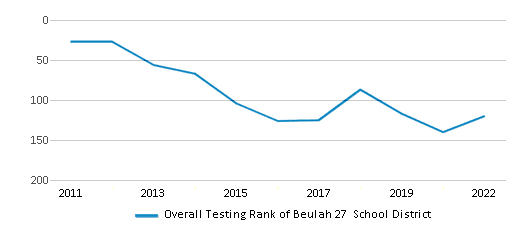
Math Test Scores (% Proficient)
38%
39%

Reading/Language Arts Test Scores (% Proficient)
39%
44%
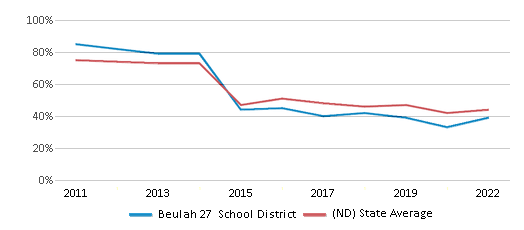
Science Test Scores (% Proficient)
30-34%
44%
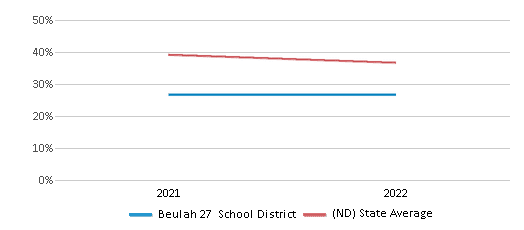
Graduation Rate
≥90%
85%
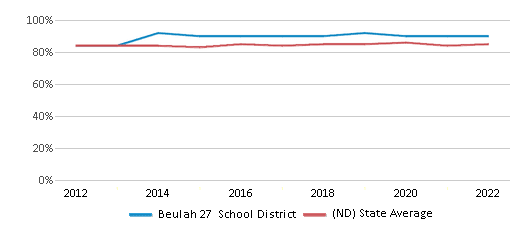
Students by Ethnicity:
Diversity Score
0.21
0.48
# American Indian Students
18 Students
5,643 Students
% American Indian Students
2%
14%
# Asian Students
3 Students
421 Students
% Asian Students
n/a
1%
# Hispanic Students
31 Students
2,286 Students
% Hispanic Students
4%
6%
# Black Students
6 Students
1,487 Students
% Black Students
1%
4%
# White Students
663 Students
27,700 Students
% White Students
89%
71%
# Hawaiian Students
n/a
91 Students
% Hawaiian Students
n/a
n/a
# Two or more races Students
26 Students
1,548 Students
% of Two or more races Students
4%
4%
Students by Grade:
# Students in PK Grade:
-
396
# Students in K Grade:
60
718
# Students in 1st Grade:
52
757
# Students in 2nd Grade:
62
783
# Students in 3rd Grade:
61
716
# Students in 4th Grade:
67
812
# Students in 5th Grade:
57
1,523
# Students in 6th Grade:
55
7,290
# Students in 7th Grade:
57
9,001
# Students in 8th Grade:
71
9,080
# Students in 9th Grade:
48
2,284
# Students in 10th Grade:
52
2,100
# Students in 11th Grade:
43
1,943
# Students in 12th Grade:
62
1,773
# Ungraded Students:
-
-
District Revenue and Spending
The revenue/student of $13,598 in this school district is less than the state median of $17,615. The school district revenue/student has stayed relatively flat over four school years.
The school district's spending/student of $25,740 is higher than the state median of $17,617. The school district spending/student has stayed relatively flat over four school years.
Total Revenue
$10 MM
$2,154 MM

Spending
$19 MM
$2,154 MM
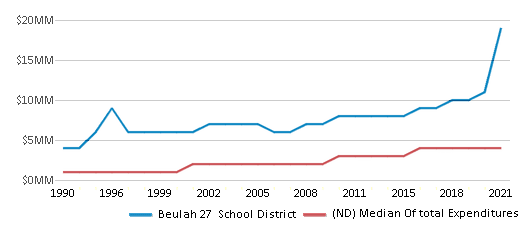
Revenue / Student
$13,598
$17,615
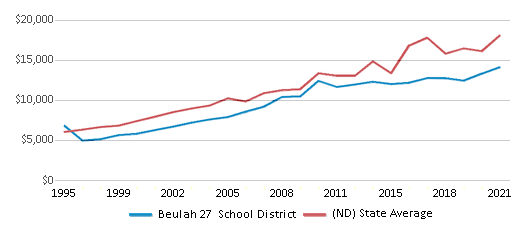
Spending / Student
$25,740
$17,617
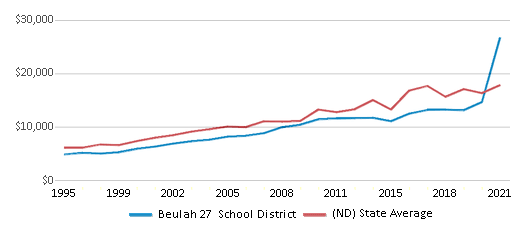
Best Beulah 27 School District Public Middle Schools (2025)
School
(Math and Reading Proficiency)
(Math and Reading Proficiency)
Location
Grades
Students
Rank: #11.
Beulah Middle School
(Math: 37% | Reading: 37%)
Rank:
Rank:
4/
Bottom 50%10
1700 Central Ave N
Beulah, ND 58523
(701) 873-4325
Beulah, ND 58523
(701) 873-4325
Grades: 5-8
| 240 students
Recent Articles

Year-Round Or Traditional Schedule?
Which is more appropriate for your child? A year-round attendance schedule or traditional schedule? We look at the pros and cons.

Why You Should Encourage Your Child to Join a Sports Team
Participating in team sports has a great many benefits for children, there is no doubt. In this article you will learn what those benefits are.

White Students are Now the Minority in U.S. 九游体育s
Increasing birth rates among immigrant families from Asia and Central and South America, combined with lower birth rates among white families, means that for the first time in history, public school students in the United States are majority-minority. This shift in demographics poses difficulties for schools as they work to accommodate children of varying language abilities and socio-economic backgrounds.





